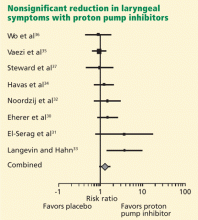Laryngopharyngeal reflux: More questions than answers
ABSTRACTLaryngopharyngeal reflux (LPR), an extraesophageal variant of gastroesophageal reflux disease, is associated with hoarseness, chronic cough, throat-clearing, sore throat, and dysphagia. But because these symptoms are nonspecific, laryngoscopy is often done and the diagnosis of LPR is considered if edema, erythema, ventricular obliteration, pseudosulcus, or postcricoid hyperplasia is noted. Most patients with suspected LPR are given a 2-month trial of a proton pump inhibitor. Yet there is still little or no solid evidence on which to base the diagnosis or the treatment of LPR. We review the current understanding of the pathophysiology and discuss current diagnostic tests and treatment regimens in patients with suspected LPR.
KEY POINTS
- Laryngoscopy has high interrater variability, and results of pH monitoring do not reliably predict who will respond to treatment.
- A proton pump inhibitor twice daily for 2 months is currently recommended for patients with laryngeal signs and symptoms. If the condition responds to therapy, tapering to once-daily therapy and then to minimal acid-suppression to control symptoms is prudent.
- Patients whose symptoms do not respond to a proton pump inhibitor are unlikely to benefit from surgery. Other diagnoses should be entertained, while the drug is tapered to prevent rebound acid reflux.
EMPIRIC PPI TREATMENT HAS SHOWN DISAPPOINTING RESULTS
Because laryngoscopy and pH monitoring are not very sensitive or specific for LPR, experts recommend empiric therapy with a PPI twice daily. However, the results have been disappointing when PPIs were compared with placebo in clinical trials.
In a randomized controlled trial,28 we found that patients who had complaints of chronic throat-clearing, cough, globus, sore throat, and hoarseness had a similar response to twice-daily esomeprazole (Nexium) compared with placebo: their primary symptom had resolved by 16 weeks in 14.7% of the esomeprazole group vs 16.0% of the placebo group (P = .799). Similarly, the final findings on laryngoscopy such as edema, erythema, and surface irregularity were not significantly different between groups.
Adding a histamine-2 receptor antagonist is not recommended
Adding a histamine-2 receptor antagonist to PPI therapy has also been considered as a treatment for LPR.
Fackler et al38 studied 16 GERD patients and 18 healthy volunteers to determine if adding ranitidine (Pepcid) to the PPI omeprazole (Prilosec) could improve GERD symptoms. Patients underwent baseline manometry and then gastroesophageal pH monitoring before starting the drugs. They first received omeprazole 20 mg twice daily alone for 2 weeks, and then added ranitidine 300 mg at bedtime. A pH test was done again after the first day of treatment with ranitidine, at the end of 1 week of combination therapy, and after 4 weeks of combination therapy. The combination reduced nocturnal acid breakthrough on day 1; however, due to tolerance to ranitidine, no significant difference in acid suppression was seen after 1 week of therapy. Therefore, this combination is not recommended.
Surgery is not recommended either
Some experts have argued for surgical fundoplication in patients whose symptoms persist despite drug therapy.
Swoger et al39 treated 72 patients who had symptoms consistent with LPR with a PPI for 4 months; 25 patients in this group had less than a 50% improvement despite maximal drug therapy. Ten of these patients underwent surgical fundoplication, and 15 remained on drug therapy alone. At 1 year of follow-up, only one surgical patient (10%) reported improvement in laryngeal symptoms.
In view of this report and prior studies of surgical fundoplication,40 surgery is not recommended for patients whose symptoms do not respond to aggressive PPI therapy.
IF A PPI FAILS, LOOK FOR OTHER CAUSES OF SYMPTOMS
Although gastroesophageal reflux and laryngeal signs and symptoms have been associated with one another, this relation may have been overstated, leading to the overdiagnosis of LPR.
The diagnosis of LPR is difficult, as laryngoscopy has high interrater variability and as the results of pH monitoring do not dependably predict who will respond to treatment.
Because PPI therapy is easy and appears to be safe, patients with extraesophageal symptoms thought to be related to reflux should undergo a trial of twice-daily PPI therapy for at least 2 months. If the patient responds to therapy, then tapering to once-daily therapy initially and then to minimal acid suppression to control symptoms would be prudent.
In patients who show no improvement, other causes of symptoms should be explored. Diseases that can mimic LPR include postnasal drip, allergies, sinus inflammation, and various pulmonary diseases. These patients should also be advised to adopt lifestyle modifications—eg, to stop smoking, lose weight, and decrease activities that cause stress on the voice. Surgery is not likely to provide any benefit in this situation. The patient should be tapered off the PPI to make sure no rebound acid reflux occurs.







